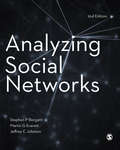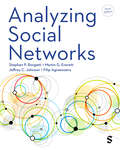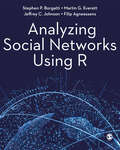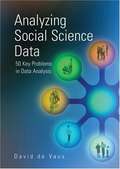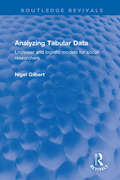- Table View
- List View
Analyzing Qualitative Data (Qualitative Research Kit #6)
by Dr Graham R. GibbsThis book tackles the challenges of how to make sense of qualitative data. It offers students and researchers a hands-on guide to the practicalities of coding, comparing data, and using computer-assisted qualitative data analysis. Lastly, Gibbs shows you how to bring it all together, so you can see the steps of qualitative analysis, understand the central place of coding, ensure analytic quality and write effectively to present your results.
Analyzing Quantitative Data: From Description to Explanation
by Norman BlaikieWhat basic knowledge and skills do novice researchers in social science require? How can students be helped to over-come `symbol phobia′ or `figure blindness′? This generous and constantly insightful book is designed for social researchers who need to know what procedures to use under what circumstances, in practical research projects. It accomplishes this without requiring an in-depth understanding of statistical theory, but also avoids both trivializing procedures or resorting to `cookbook′ techniques. Among the key features of the book are: - Accessibility - Organization of the wide, often bewildering array of methods of data analysis into a coherent and user-friendly scheme of classification: types of analysis and levels of measurement - Demystification - the first chapter unpacks commonly taken-for-granted concepts such as `analysis′, `data′ and `quantitative′ - Location of methods in real research problems The book is a triumphant introduction to the theory and practice of quantitative methods. It will quickly establish itself as essential reading for students doing social research throughout the social sciences. `With this book Norman Blaikie retains his reputation as the leading rapporteur and raconteur of social research methodology. With many other introductory texts, data analysis becomes just an exercise unto itself, and students (sometimes) learn to go through the motions without really knowing why. After working with Blaikie′s text, novice researchers will know why quantitative inquiry is important′ - Ray Pawson, University of Leeds
Analyzing Quantitative Data: From Description to Explanation
by Norman BlaikieWhat basic knowledge and skills do novice researchers in social science require? How can students be helped to over-come `symbol phobia′ or `figure blindness′? This generous and constantly insightful book is designed for social researchers who need to know what procedures to use under what circumstances, in practical research projects. It accomplishes this without requiring an in-depth understanding of statistical theory, but also avoids both trivializing procedures or resorting to `cookbook′ techniques. Among the key features of the book are: - Accessibility - Organization of the wide, often bewildering array of methods of data analysis into a coherent and user-friendly scheme of classification: types of analysis and levels of measurement - Demystification - the first chapter unpacks commonly taken-for-granted concepts such as `analysis′, `data′ and `quantitative′ - Location of methods in real research problems The book is a triumphant introduction to the theory and practice of quantitative methods. It will quickly establish itself as essential reading for students doing social research throughout the social sciences. `With this book Norman Blaikie retains his reputation as the leading rapporteur and raconteur of social research methodology. With many other introductory texts, data analysis becomes just an exercise unto itself, and students (sometimes) learn to go through the motions without really knowing why. After working with Blaikie′s text, novice researchers will know why quantitative inquiry is important′ - Ray Pawson, University of Leeds
Analyzing Quantitative Data: From Description to Explanation
by Blaikie, Norman W. H.What basic knowledge and skills do novice researchers in social science require? How can students be helped to over-come symbol phobia' or figure blindness'? This generous and constantly insightful book is designed for social researchers who need to know what procedures to use under what circumstances, in practical research projects. It accomplishes this without requiring an in-depth understanding of statistical theory, but also avoids both trivializing procedures or resorting to cookbook' techniques. Among the key features of the book are: - Accessibility - Organization of the wide, often bewildering array of methods of data analysis into a coherent and user-friendly scheme of classification: types of analysis and levels of measurement - Demystification - the first chapter unpacks commonly taken-for-granted concepts such as analysis', data' and quantitative' - Location of methods in real research problems The book is a triumphant introduction to the theory and practice of quantitative methods. It will quickly establish itself as essential reading for students doing social research throughout the social sciences. With this book Norman Blaikie retains his reputation as the leading rapporteur and raconteur of social research methodology. With many other introductory texts, data analysis becomes just an exercise unto itself, and students (sometimes) learn to go through the motions without really knowing why. After working with Blaikie's text, novice researchers will know why quantitative inquiry is important' - Ray Pawson, University of Leeds
Analyzing Rational Crime — Models and Methods (Theory and Decision Library A: #36)
by Olof DahlbäckOlof Dahlbäck's book breaks new ground for the analysis of crime from a rationality perspective by presenting models and methods that go far beyond those with which researchers have hitherto been equipped. The book examines single crimes, individual criminality, and societal crime, and it discusses thoroughly the general decision theoretical presuppositions necessary for analyzing these various types of crime. An expected utility maximization model for a single discrete choice regarding the commission of a crime is the foundation of most of the analyses presented. A version of this model is developed that permits interpersonal comparisons, and this basic model is used when deriving more complex models of crime as well as when analyzing the potential for such derivations. The rigorous, powerful methods suggested provide considerable opportunities for improving research and for seeing old problems in a new light.
Analyzing Single System Design Data (Pocket Guide to Social Work Research Methods)
by William NugentSingle system, or single case, design studies are a convenient method for evaluating practice, allowing professionals to track clients' response to treatment and change over time. They also allow researchers to gather data where it might be difficult to conduct a study involving treatment and control groups; in a school setting, or a community mental health agency, for example, random assignment may be impossible, whereas individual student or client progress across time can be more easily monitored. This pocket guide reviews a wide range of techniques for analyzing single system design data, including visual analysis methods, graphical methods, and statistical methods. From basic visual observation to complex ARIMA statistical models for use with interrupted time series designs, numerous data analysis methods are described and illustrated in this unique and handy book. The author frankly describes limitations and strengths of the data analysis methods so that readers can select an appropriate method and use the results responsibly in order to improve practice and client well-being. This accessible yet in-depth introduction will serve as a highly practical resource for doctoral students and researchers alike.
Analyzing Social and Political Change: A Casebook of Methods (PDF)
by Professor Angela Dale Professor Richard DaviesUnderstanding change over time is a central concern for research in sociology, political science, education, geography and related disciplines. It is also an issue which presents significant methodological problems, in response to which different techniques have been developed - for example, time series analysis, multilevel models, log-linear models and event history analysis. Outlining the nature of such techniques, this accessible collection covers: the respective values of cross-sectional and longitudinal data in the analysis of change; the variety of methods available for the analysis of change over time; the types of research objective to which various techniques are suited; the limitations and constraints of individual methods; and the different philosophies which underlie particular approaches.
Analyzing Social Media Data and Web Networks
by Rachel Gibson Stephen Ward Marta CantijochAs governments, citizens and organizations have moved online there is an increasing need for academic enquiry to adapt to this new context for communication and political action. This adaptation is crucially dependent on researchers being equipped with the necessary methodological tools to extract, analyze and visualize patterns of web activity. This volume profiles the latest techniques being employed by social scientists to collect and interpret data from some of the most popular social media applications, the political parties' own online activist spaces, and the wider system of hyperlinks that structure the inter-connections between these sites. Including contributions from a range of academic disciplines including Political Science, Media and Communication Studies, Economics, and Computer Science, this study showcases a new methodological approach that has been expressly designed to capture and analyze web data in the process of investigating substantive questions.
Analyzing Social Narratives (Routledge Series on Interpretive Methods)
by Shaul R. ShenhavInterpreting human stories, whether those told by individuals, groups, organizations, nations, or even civilizations, opens a wide scope of research options for understanding how people construct, shape, and reshape their perceptions, identities, and beliefs. Such narrative research is a rapidly growing field in the social sciences, as well as in the societally oriented humanities, such as cultural studies. This methodologically framed book offers conceptual directions for the study of social narrative, guiding readers through the means of narrative research and raising important ethical and value-related dilemmas. Shenhav details three classic elements of narrative—text, story, and narration—familiar concepts to those in literary studies. To the classic trilolgy of terms, this book also adds multiplicity, a crucial element for applying narrative analysis to the social sciences as it rests on the understanding that social narratives seek reproduction and self-multiplicity in order to become "social" and influential. The aim of this book is to create an easy, clear, and welcoming introduction to narratology as a mode of analysis, especially designed for students of the social sciences to provide the basics of a narratological approach, and to help make research and writing in this tradition more systematic. .
Analyzing Social Narratives (Routledge Series on Interpretive Methods)
by Shaul R. ShenhavInterpreting human stories, whether those told by individuals, groups, organizations, nations, or even civilizations, opens a wide scope of research options for understanding how people construct, shape, and reshape their perceptions, identities, and beliefs. Such narrative research is a rapidly growing field in the social sciences, as well as in the societally oriented humanities, such as cultural studies. This methodologically framed book offers conceptual directions for the study of social narrative, guiding readers through the means of narrative research and raising important ethical and value-related dilemmas. Shenhav details three classic elements of narrative—text, story, and narration—familiar concepts to those in literary studies. To the classic trilolgy of terms, this book also adds multiplicity, a crucial element for applying narrative analysis to the social sciences as it rests on the understanding that social narratives seek reproduction and self-multiplicity in order to become "social" and influential. The aim of this book is to create an easy, clear, and welcoming introduction to narratology as a mode of analysis, especially designed for students of the social sciences to provide the basics of a narratological approach, and to help make research and writing in this tradition more systematic. .
Analyzing Social Networks
by Stephen P Borgatti Martin G. Everett Jeffrey C. JohnsonDesigned to walk beginners through core aspects of collecting, visualizing, analyzing, and interpreting social network data, this book will get you up-to-speed on the theory and skills you need to conduct social network analysis. Using simple language and equations, the authors provide expert, clear insight into every step of the research process—including basic maths principles—without making assumptions about what you know. With a particular focus on NetDraw and UCINET, the book introduces relevant software tools step-by-step in an easy to follow way. In addition to the fundamentals of network analysis and the research process, this new Second Edition focuses on: Digital data and social networks like Twitter Statistical models to use in SNA, like QAP and ERGM The structure and centrality of networks Methods for cohesive subgroups/community detection Supported by new chapter exercises, a glossary, and a fully updated companion website, this text is the perfect student-friendly introduction to social network analysis.
Analyzing Social Networks
by Stephen P Borgatti Martin G. Everett Jeffrey C. JohnsonDesigned to walk beginners through core aspects of collecting, visualizing, analyzing, and interpreting social network data, this book will get you up-to-speed on the theory and skills you need to conduct social network analysis. Using simple language and equations, the authors provide expert, clear insight into every step of the research process—including basic maths principles—without making assumptions about what you know. With a particular focus on NetDraw and UCINET, the book introduces relevant software tools step-by-step in an easy to follow way. In addition to the fundamentals of network analysis and the research process, this new Second Edition focuses on: Digital data and social networks like Twitter Statistical models to use in SNA, like QAP and ERGM The structure and centrality of networks Methods for cohesive subgroups/community detection Supported by new chapter exercises, a glossary, and a fully updated companion website, this text is the perfect student-friendly introduction to social network analysis.
Analyzing Social Networks
by Stephen P Borgatti Martin G. Everett Jeffrey C. Johnson Filip AgneessensKickstart your research with this practical, bestselling guide to doing social network analysis. Get to grips with the mathematical foundations and learn how to use software tools such as NeTDraw and UNICET to reach your research goals. Supporting you step-by-step through the entire research process, from design and data collection to coding, visualisation, and analysis, the book also offers: • Case studies and examples using real data • Exercises drawn from the authors’ decades of teaching experience • Online access to datasets, worked examples and a software manual to help you practice your skills. Whether you are new to social network analysis or an experienced researcher, this approachable book is your technical toolbox and research companion all in one.
Analyzing Social Networks
by Stephen P Borgatti Martin G. Everett Jeffrey C. Johnson Filip AgneessensKickstart your research with this practical, bestselling guide to doing social network analysis. Get to grips with the mathematical foundations and learn how to use software tools such as NeTDraw and UNICET to reach your research goals. Supporting you step-by-step through the entire research process, from design and data collection to coding, visualisation, and analysis, the book also offers: • Case studies and examples using real data • Exercises drawn from the authors’ decades of teaching experience • Online access to datasets, worked examples and a software manual to help you practice your skills. Whether you are new to social network analysis or an experienced researcher, this approachable book is your technical toolbox and research companion all in one.
Analyzing Social Networks
by Stephen P Borgatti Martin G. Everett Jeffrey C. Johnson Filip AgneessensKickstart your research with this practical, bestselling guide to doing social network analysis. Get to grips with the mathematical foundations and learn how to use software tools such as NeTDraw and UNICET to reach your research goals. Supporting you step-by-step through the entire research process, from design and data collection to coding, visualisation, and analysis, the book also offers: • Case studies and examples using real data • Exercises drawn from the authors’ decades of teaching experience • Online access to datasets, worked examples and a software manual to help you practice your skills. Whether you are new to social network analysis or an experienced researcher, this approachable book is your technical toolbox and research companion all in one.
Analyzing Social Networks (1st edition)
by Jeffrey C. Johnson Martin G. Everett Stephen P BorgattiWritten by a stellar team of experts, Analyzing Social Networks is a practical book on how to collect, visualize, analyze and interpret social network data with a particular emphasis on the use of the software tools UCINET and Netdraw. The book includes a clear and detailed introduction to the fundamental concepts of network analyses, including centrality, subgroups, equivalence and network structure, as well as cross-cutting chapters that helpfully show how to apply network concepts to different kinds of networks. Written using simple language and notation with few equations, this book masterfully covers the research process, including: · The initial design stage · Data collection and manipulation · Measuring key variables · Exploration of structure · Hypothesis testing · Interpretation This is an essential resource for students, researchers and practitioners across the social sciences who want to use network analysis as part of their research. Available with Perusall—an eBook that makes it easier to prepare for class Perusall is an award-winning eBook platform featuring social annotation tools that allow students and instructors to collaboratively mark up and discuss their SAGE textbook. Backed by research and supported by technological innovations developed at Harvard University, this process of learning through collaborative annotation keeps your students engaged and makes teaching easier and more effective. Learn more.
Analyzing Social Networks (PDF)
by Jeffrey C. Johnson Martin G. Everett Stephen P BorgattiWritten by a stellar team of experts, Analyzing Social Networks is a practical book on how to collect, visualize, analyze and interpret social network data with a particular emphasis on the use of the software tools UCINET and Netdraw. The book includes a clear and detailed introduction to the fundamental concepts of network analyses, including centrality, subgroups, equivalence and network structure, as well as cross-cutting chapters that helpfully show how to apply network concepts to different kinds of networks. Written using simple language and notation with few equations, this book masterfully covers the research process, including: · The initial design stage · Data collection and manipulation · Measuring key variables · Exploration of structure · Hypothesis testing · Interpretation This is an essential resource for students, researchers and practitioners across the social sciences who want to use network analysis as part of their research. Available with Perusall—an eBook that makes it easier to prepare for class Perusall is an award-winning eBook platform featuring social annotation tools that allow students and instructors to collaboratively mark up and discuss their SAGE textbook. Backed by research and supported by technological innovations developed at Harvard University, this process of learning through collaborative annotation keeps your students engaged and makes teaching easier and more effective. Learn more.
Analyzing Social Networks Using R
by Jeffrey C. Johnson Martin G. Everett Stephen P. Borgatti Filip AgneessensThis approachable book introduces network research in R, walking you through every step of doing social network analysis. Drawing together research design, data collection and data analysis, it explains the core concepts of network analysis in a non-technical way. The book balances an easy to follow explanation of the theoretical and statistical foundations underpinning network analysis with practical guidance on key steps like data management, preparation and visualisation. With clarity and expert insight, it: • Discusses measures and techniques for analyzing social network data, including digital media • Explains a range of statistical models including QAP and ERGM, giving you the tools to approach different types of networks • Offers digital resources like practice datasets and worked examples that help you get to grips with R software
Analyzing Social Networks Using R
by Jeffrey C. Johnson Martin G. Everett Stephen P. Borgatti Filip AgneessensThis approachable book introduces network research in R, walking you through every step of doing social network analysis. Drawing together research design, data collection and data analysis, it explains the core concepts of network analysis in a non-technical way. The book balances an easy to follow explanation of the theoretical and statistical foundations underpinning network analysis with practical guidance on key steps like data management, preparation and visualisation. With clarity and expert insight, it: • Discusses measures and techniques for analyzing social network data, including digital media • Explains a range of statistical models including QAP and ERGM, giving you the tools to approach different types of networks • Offers digital resources like practice datasets and worked examples that help you get to grips with R software
Analyzing Social Networks Using R
by Jeffrey C. Johnson Martin G. Everett Stephen P. Borgatti Filip AgneessensThis approachable book introduces network research in R, walking you through every step of doing social network analysis. Drawing together research design, data collection and data analysis, it explains the core concepts of network analysis in a non-technical way. The book balances an easy to follow explanation of the theoretical and statistical foundations underpinning network analysis with practical guidance on key steps like data management, preparation and visualisation. With clarity and expert insight, it: • Discusses measures and techniques for analyzing social network data, including digital media • Explains a range of statistical models including QAP and ERGM, giving you the tools to approach different types of networks • Offers digital resources like practice datasets and worked examples that help you get to grips with R software
Analyzing Social Science Data: 50 Key Problems In Data Analysis (PDF)
by David De VausIn this novel and refreshing textbook, David de Vaus directs students to the core of data analysis. The book is an authoritative guide to the problems facing beginners in the field. Analyzing Social Science Data guides students in: problems with the initial data; problems with the initial variables; how to handle too much data; how to generalize; problems of analyzing single variables; problems examining bivariate relationships; and problems examining multivariate relationships The book is a tour de force in making data analysis manageable and rewarding for today's undergraduate studying research methods. `I'm full of admiration for this book. Once again, David de Vaus has come up with a superb book that is well written and organized and which will be a boon to a wide range of students. He has taken a vast array of problems that users of quantitative data analysis procedures are likely to encounter. The selection of issues and problems . . . reflects the experience of a true practitioner with a grasp of his field and of the intricacies of the research process. The selection of issues clearly derives also from experience of teaching students how to do research and analyse data. . . . A large number of practitioners will want the book. I was surprised at how much I learned from this. This will be a vital book for the bookshelves of practitioners of the craft of quantitative data analysis' - Alan Bryman, Professor of Social Research, Loughborough University
Analyzing Tabular Data: Loglinear and logistic models for social researchers (Routledge Revivals)
by Nigel GilbertFirst published in 1993, Analyzing Tabular Data is an accessible text introducing a powerful range of analytical methods. Empirical social research almost invariably requires the presentation and analysis of tables, and this book is for those who have little prior knowledge of quantitative analysis or statistics, but who have a practical need to extract the most from their data. The book begins with an introduction to the process of data analysis and the basic structure of cross-tabulations. At the core of the methods described in the text is the loglinear model. This and the logistic model, are explained and their application to causal modelling, to event history analysis, and to social mobility research are described in detail. Each chapter concludes with sample programs to show how analysis on typical datasets can be carried out using either the popular computer packages, SPSS, or the statistical programme, GLIM. The book is packed with examples which apply the methods to social science research. Sociologists, geographers, psychologists, economists, market researchers and those involved in survey research in the fields of planning, evaluation and policy will find the book to be a clear and thorough exposition of methods for the analysis of tabular data.
Analyzing Tabular Data: Loglinear and logistic models for social researchers (Routledge Revivals)
by Nigel GilbertFirst published in 1993, Analyzing Tabular Data is an accessible text introducing a powerful range of analytical methods. Empirical social research almost invariably requires the presentation and analysis of tables, and this book is for those who have little prior knowledge of quantitative analysis or statistics, but who have a practical need to extract the most from their data. The book begins with an introduction to the process of data analysis and the basic structure of cross-tabulations. At the core of the methods described in the text is the loglinear model. This and the logistic model, are explained and their application to causal modelling, to event history analysis, and to social mobility research are described in detail. Each chapter concludes with sample programs to show how analysis on typical datasets can be carried out using either the popular computer packages, SPSS, or the statistical programme, GLIM. The book is packed with examples which apply the methods to social science research. Sociologists, geographers, psychologists, economists, market researchers and those involved in survey research in the fields of planning, evaluation and policy will find the book to be a clear and thorough exposition of methods for the analysis of tabular data.
Analyzing Talk in the Social Sciences: Narrative, Conversation and Discourse Strategies (PDF)
by Katherine Bischoping Amber GazsoTalk is one of the main resources available to qualitative researchers. It offers rich, meaningful data that can provide real insights and new perspectives. But once you have the data how do you select an appropriate means of analysis? How do you ensure that the approach you adopt is the best for your project and your data? The book will help you choose strategies for qualitative analysis that best suit your research. It walks you through key decisions, provides actionable game plans and highlights the advantages and challenges of the main approaches. It is packed full of real examples designed to showcase the different tools you might use to meet your own objectives. Each section of the book focuses on one popular strategy for analyzing talk-based data: Narrative Analysis Conversation Analysis Discourse Analysis Taken together these sections will help you to fine-tune the link between your primary research question and your methods; to ensure that your theoretical stance fits with your methods; and to reason through your analysis in a way that will be recognizable to the intellectual communities of narrative, conversation, or discourse analysts. This book is both starting point and map for any social scientist looking to strategically and purposefully analyse talk data.
Analyzing Talk in the Social Sciences: Narrative, Conversation and Discourse Strategies
by Katherine Bischoping Amber GazsoTalk is one of the main resources available to qualitative researchers. It offers rich, meaningful data that can provide real insights and new perspectives. But once you have the data how do you select an appropriate means of analysis? How do you ensure that the approach you adopt is the best for your project and your data? The book will help you choose strategies for qualitative analysis that best suit your research. It walks you through key decisions, provides actionable game plans and highlights the advantages and challenges of the main approaches. It is packed full of real examples designed to showcase the different tools you might use to meet your own objectives. Each section of the book focuses on one popular strategy for analyzing talk-based data: Narrative Analysis Conversation Analysis Discourse Analysis Taken together these sections will help you to fine-tune the link between your primary research question and your methods; to ensure that your theoretical stance fits with your methods; and to reason through your analysis in a way that will be recognizable to the intellectual communities of narrative, conversation, or discourse analysts. This book is both starting point and map for any social scientist looking to strategically and purposefully analyse talk data.









